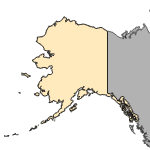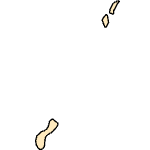Crocodylus niloticus
(Nile Crocodile)
Reptiles-Crocodilians
Exotic |
|
Common name: Nile Crocodile
Synonyms and Other Names: mamba
Taxonomy: available through
www.itis.gov
Identification: A very large crocodile averaging an overall length of 5 m (16 ft) and, perhaps exceeding 5.5 m (18 ft) (Cott, 1961; Ross and Magnusson, 1989; Grenard, 1991; Branch, 1998; Jones, 1998). Unlike the noticeably blunt-snouted American alligator (Alligator mississippiensis), the only crocodilian indigenous to Mississippi, the snout of Crocodylus niloticus is more pointed, with a larger number of teeth conspicuously protruding from the mouth when closed (Neill, 1971; Ross and Magnusson, 1989; Branch, 1993, 1998). The dorsal coloration in adults is a uniformly or blotched olive or gray, with darker crossbands on the tail, while juveniles are olive brown to green with more conspicuous black crossbands on the body and tail (Branch, 1993, 1998; Ross and Magnusson, 1989). The belly is typically straw-yellow (Branch, 1998). Illustrated in Neill (1971), Guggisberg (1972), Ross and Magnusson (1989), Graham (1990), Branch (1993, 1998), and Lamar (1997).
Size: 5 m overall length on average
Native Range: Indigenous distribution of C. niloticus ranges throughout most of the African continent, excluding much of northern, especially northwestern, Africa and extreme southwestern Africa, but including Madagascar and the Nile River Valley (Cansdale, 1955; Groombridge, 1987; King, 1989; Ross and Magnusson, 1989; Grenard, 1991; Branch, 1993, 1998). Historically the Nile crocodile's range included Israel, Syria, Comoros, and the Seychelles (King, 1989; Ross and Magnusson, 1989).



|

Alaska |

Hawaii |

Puerto Rico &
Virgin Islands |

Guam Saipan |
Hydrologic Unit Codes (HUCs) Explained
Interactive maps: Point Distribution Maps
Nonindigenous Occurrences:
Table 1. States with nonindigenous occurrences, the earliest and latest observations in each state, and the tally and names of HUCs with observations†. Names and dates are hyperlinked to their relevant specimen records. The list of references for all nonindigenous occurrences of Crocodylus niloticus are found here.
Table last updated 12/19/2025
† Populations may not be currently present.
Ecology: Crocodylus niloticus is an omnicarnivorous, primarily aquatic, predator that eats fish, turtles and other reptiles, small and large mammals (including zebra and buffalo), birds, carrion, invertebrates and any other animal it can overpower, swallow whole or rip apart, and ingest (Roosevelt, 1909; Cansdale, 1955; Cott, 1961; Grenard, 1991; Branch, 1993, 1998; Lamar, 1997). In many parts of Africa, humans are commonly preyed upon by Nile crocodiles; therefore, fatal attacks and consumption by these large predators are well-documented (Candale, 1955; Guggisberg, 1972; Pooley et al., 1989; Graham, 1990; Allen, 1998; Branch, 1998). Nile crocodiles are highly fecund; females lay eggs dug out of the sand and aggressively guard the nest (Cansdale, 1955; Cott, 1961; Lang, 1987; Magnusson et al., 1989; Branch, 1993, 1998; Allen, 1998). Hatchling gender is determined by the heat of the sun-warmed nest; lower temperatures produce mostly females while higher temperatures produce mostly males (Branch, 1998). Hatchling C. niloticus may die if the mother is not present to dig them out of the nest (Jones, 1998). Parental care of the hatchlings and growing juveniles by the mother (and sometimes an attendant male) is relatively sophisticated; ranging from transport of the young to water, to aggressive defense of the brood from predators (T. Jones in Cansdale, 1955; Hadley, 1969; Pooley, 1974a, b, 1977; Pooley and Gans, 1976; Lang, 1987, 1989; Magnusson et al., 1989; Branch, 1993, 1998). This conspicuous parental behavior has been known since the days of Aristotle and Pliny the Elder (Shine, 1988), and was even discussed by Vansleb (1678).
Means of Introduction: A natural catastrophe (flooding from Hurricane Georges) caused their release from confinement in a breeding facility (M. Duran in Anonymous, 1998).
Status: Not established; all five escapees were quickly recaptured (Anonymous, 1998).
Impact of Introduction: The impacts of this species are currently unknown, as no studies have been done to determine how it has affected ecosystems in the invaded range. The absence of data does not equate to lack of effects. It does, however, mean that research is required to evaluate effects before conclusions can be made.
References: (click for full references)
Allen, D. 1998. Nile crocodiles in Zimbabwe. Reptile & Amphibian Magazine (52):18-22.
Anonymous. 1998. Hurricane Georges frees Nile crocs. Crocodile Specialist Group Newsletter (IUCN) 17(4):15.
Branch, B. [=W. R.] 1993. Southern African Snakes and Other Reptiles. A Photographic Guide. New Holland (Publishers) Ltd, London. 144 pp.
Branch, B. [=W. R.] 1998. Field Guide to Snakes and Other Reptiles of Southern Africa. Third Revised Edition. Ralph Curtis Books Publishing, Sanibel Island, Florida. 399 pp.
Cansdale, G. 1955. Reptiles of West Africa. Penguin Books Ltd, Harmondsworth, England. 104 pp.
Child, G. 1987. The management of crocodiles in Zimbabwe. Pp. 49-62. In: G. J. W. Webb, S. C. Manolis, and P. J. Whitehead (editors). Wildlife Management: Crocodiles and Alligators. Surrey Beatty & Sons Pty Limited, Chipping Norton, Australia. 552 pp.
Cott, H. B. 1961. Scientific results of an inquiry into the ecology and economic status of the Nile crocodile (Crocodilus niloticus) in Uganda and Northern Rhodesia. Transactions of the Zoological Society of London 29(4):211-356, plates 1-9.
Graham, A. [D.] 1990. Eyelids of Morning. The Mingled Destinies of Crocodiles and Men. First Chronicle Books Edition. Chronicle Books, San Francisco. 260 pp.
Grenard, S. 1991. Handbook of Alligators and Crocodiles. Krieger Publishing Company, Malabar, Florida. 210 pp.
Groombridge, B. 1987. The distribution and status of world crocodilians. Pp. 9-21. In: G. J. W. Webb, S. C. Manolis, and P. J. Whitehead (editors). Wildlife Management: Crocodiles and Alligators. Surrey Beatty & Sons Pty Limited, Chipping Norton, Australia. 552 pp.
Guggisberg, C. A. W. 1972. Crocodiles. Their Natural History, Folklore and Conservation. Stackpole Books, Harrisburg, Pennsylvania. 204 pp.
Hadley, D. 1969. Breeding of crocodile in Livingstone Game Park. Puku (Chilange, Zambia) (5):226-228.
Jones, A. 1998. Croc adventures in retrospect, forty years later. Reptile & Amphibian Magazine (53):54-63.
King, [F.] W. 1989. Crocodylus niloticus Laurenti 1768. Pp. 11-12. In: F. W. King and R. L. Burke (editors). Crocodilian, Tuatara, and Turtle Species of the World. A Taxonomic and Geographic Reference. The Association of Systematics Collections, Washington, DC. 216 pp.
Lamar, W. W. 1997. The World's Most Spectacular Reptiles & Amphibians. World Publications, Tampa. 210 pp.
Lang, J. W. 1987. Crocodilian behaviour: Implications for management. Pp. 273-294. In: G. J. W. Webb, S. C. Manolis, and P. J. Whitehead (editors). Wildlife Management: Crocodiles and Alligators. Surrey Beatty & Sons Pty Limited, Chipping Norton, Australia. 552 pp.
Lang, J. W. 1989. Social behavior. Pp. 102-117. In: C. A. Ross (consulting editor). Crocodiles and Alligators. Facts on File, Inc., New York. 240 pp.
Levell, J. P. 1997. A Field Guide to Reptiles and the Law. Second Revised Edition. Serpent's Tale Natural History Book Distributors, Lanesboro, Minnesota. 270 pp.
Magnusson, W. E., K. A. Vliet, A. C. (Tony) Pooley, and R. Whitaker. 1989. Reproduction. Pp. 118-135. In: C. A. Ross (consulting editor). Crocodiles and Alligators. Facts on File, Inc., New York. 240 pp.
Neill, W. T. 1971. The Last of the Ruling Reptiles: Alligators, Crocodiles, and Their Kin. Columbia University Press, New York and London. 486 pp.
Pooley, A. C. 1974a. Parental care in the Nile crocodile: A preliminary report on behaviour in a cative female. Lammergeyer (Pietermaritzberg) 3:43-45.
Pooley, A. C. 1974b. How does a baby crocodile get to water? African Wildlife 28(4):8-11.
Pooley, A. C. 1977. Nest opening response of the Nile crocodile Crocodylus niloticus. Journal of Zoology (London) 182:17-26.
Pooley, A. C., and C. Gans. 1976. The Nile crocodile. Scientific American 234(4):114-124.
Pooley, A. C. (Tony), T. C. Hines, and J. Shield. 1989. Attacks on humans. Pp. 172-187. In: C. A. Ross (consulting editor). Crocodiles and Alligators. Facts on File, Inc., New York. 240 pp.
Roosevelt, T. 1909. African Game Trails. An Account of the African Wanderings of An American Hunter-Naturalist. Vols I-II. Charles Scribner's Sons, New York. 676 pp.
Ross, C. A. (consulting editor). 1989. Crocodiles and Alligators. Facts on File, Inc., New York. 240 pp.
Ross, C. A., and W. E. Magnusson. 1989. Living crocodilians. Pp. 58-73. In: C. A. Ross (consulting editor). Crocodiles and Alligators. Facts on File, Inc., New York. 240 pp.
Shine, R. 1988 [1987]. Parental care in reptiles. Pp. 275-329. In: C. Gans and R. B. Huey (editors). Biology of the Reptilia. Ecology B. Defense and Life History. Vol. 16. Alan R. Liss, New York. 659 pp.
Vansleb [=Wansleben, J. M. or Vanslebius]. 1678. The Present State of Egypt; or, a New Relation of a Late Voyage into That Kingdom. Perfomed in the Year 1672. and 1673. R. E. for John Starkey, London. 259 pp.
Webb, G. J. W., S. C. Manolis, and P. J. Whitehead (editors). 1987. Wildlife Management: Crocodiles and Alligators. Surrey Beatty & Sons Pty Limited, Chipping Norton, Australia. 552 pp.
Author:
Somma, L.A.
Revision Date: 6/29/2023
Citation Information:
Somma, L.A., 2025, Crocodylus niloticus Laurenti, 1768: U.S. Geological Survey, Nonindigenous Aquatic Species Database, Gainesville, FL, https://nas.er.usgs.gov/queries/factsheet.aspx?SpeciesID=2273, Revision Date: 6/29/2023, Access Date: 12/19/2025
This information is preliminary or provisional and is subject to revision. It is being provided to meet the need for timely best science. The information has not received final approval by the U.S. Geological Survey (USGS) and is provided on the condition that neither the USGS nor the U.S. Government shall be held liable for any damages resulting from the authorized or unauthorized use of the information.